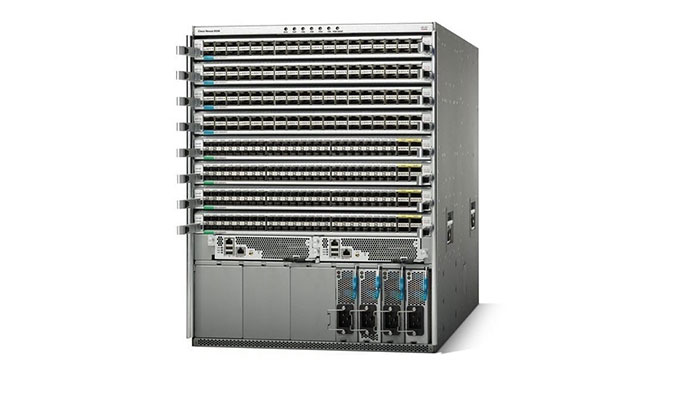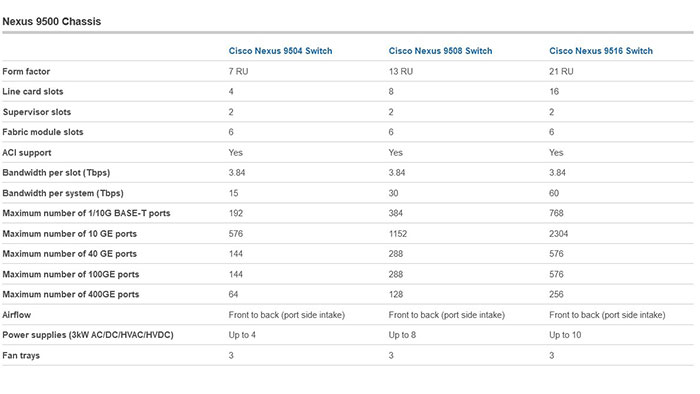
Essentially, The Cisco Nexus 9508 switch is the first modular chassis-based switch in the Cisco Nexus 9500 switches series. The Cisco Nexus 9508 is a modular, 8-slot, 13 RU high, layer 2 and 3 non-blocking Ethernet and Fiber Channel over Ethernet-capable Cisco switch. With more than 30 Tbps of backplane bandwidth, this platform supports 1/10/40 and 100 Gigabit Ethernet interfaces through a comprehensive selection of modular line cards.
Configurable with up to 1152 10G Ethernet ports or 288 40G Ethernet ports, the switch provides sufficient capacity for both access and aggregation layer deployments. The Cisco Nexus 9508 is a modular chassis that supports up to eight-line cards, has two redundant supervisor modules, two redundant system controllers, three fan trays, up to six fabric modules, and up to eight power supplies. All major components are redundant, including the supervisors, the system controllers, the power supplies and the fan trays.
The switch line cards use a mix of merchant and Cisco ASIC provide innovative functionality, low complexity and cost-optimized design. One of examples here is the hardware will support not only VXLAN bridging but also VXLAN routing functionality on the same switch which is very important for modern cloud data centers where customers expect end-to-end visibility and control across their virtual and physical switch infrastructure. Furthermore, the buffer memory is integrated into the forwarding ASICs, avoiding the need for a large number of external memory modules. All transceivers are pluggable to support the highest possible availability for the switch.
The Cisco Nexus 9500 platform is the first switch chassis designed without mid-plane. Line cards and fabric modules connect directly. This design approach provides optimal front-to-back airflow helps the switch operate using less power. Therefore, the typical power consumption per 10 Gigabit Ethernet port is less than 3.5W and the typical power consumption for each 40 Gigabit Ethernet port is less than 14W.

There are three different line cards available for these switches. The first one is the 36-port truly non-blocking 40 Gigabit Ethernet line card, with QSPF+ interfaces. This can card is designed for use in aggregation switch. The second two line cards are 48 port line cards that both have 4-port 40 Gigabit Ethernet uplinks or downlinks for server uplink connectivity. The first version of it has a 1 and 10 Gigabit Ethernet SFP+ for fiber connectivity.
The second line card has 48-port 1/10GBASE-T interfaces. The copper line card, the second one, is ideal for customers that need to replace Catalyst 6800 End-of-Row switches in their data center access and want the option to migrate from 1 Gb to 10 Gb copper without changing their network design.
These redundant supervisors allow the switch to operate in state-synchronized active-standby mode. In addition, we have two system controllers in the back of the chassis. These controllers are redundant and they offload chassis management functions from the supervisor modules.

The Nexus 9500 chassis can have up to eight hot-swappable power supplies but a fully loaded chassis can operate with two of 3000W AC power supplies which provides N+1 and N+N redundancy. The power supplies are platinum-rated which means that they can offer robust power efficiency across all workloads.
Overall, these switches play an important role in Cisco Application Centric Infrastructure (ACI) architecture and can take part as Spine switches using their Cisco ACI mode.
Cisco 9500 spine switches can support both DCN and NX-OS licenses. Also, highly-secure environments can benefit from Cisco Nexus PLR licenses to enable all instances permanently.